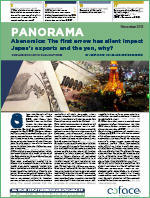Abenomics: The First Arrow Has Silent Impact On Japan’s Exports and the Yen, Why?

Since the launch of the Abenomics in early 2013, the focus has largely been on its first arrow, i.e., the aggressive monetary stimulus which the Bank of Japan (BOJ) kick-started in April 2013. Markets always call for - and in general welcome - the more expansionary monetary policy, but there have been numerous questions over the impact of the first arrow. In this report, we aim to provide some insights into the following two key questions.
I. Why did the yen depreciation, which occurred during the early success of the first arrow, not boost Japan’s merchandise exports?
One easy explanation would be to blame the external forces of subpar world economic growth, which has been weighing on global merchandise trade activities, including Japan’s exports. A more structural reason is the “pricing-to-market” behaviour of Japanese exporters, which is keeping export prices at the foreign-currency equivalent of their domestic prices steady, despite the level of the yen. Thus, stimulation of the demand for Japan’s exports would be limited.
This pricing-to-market behaviour of Japanese exporters may not be welcome by the BOJ, but it has probably helped to contribute to the growth of Japanese manufacturers’ operating profits since the depreciation of the yen in recent years, as they have been largely export-oriented.
Another important factor determining the impact of the yen’s fluctuations on the profitability of Japanese manufacturers could be the share of invoice currency in their exports. Industries with a lower degree of exported product differentiation, resulting in a smaller share of yen invoicing, are more sensitive to fluctuations in the yen. These industry players are therefore more vulnerable during times of yen strengthening, but enjoy boosted profitability during times of yen weakening. Combining these theoretical and empirical assessments, the textile and chemical industries are more vulnerable in times of yen strengthening, while the general machinery industry is relatively less so.
II. Why has the more expansionary monetary policy introduced by the BOJ been losing steam on driving down the yen since 2016?
Against the backdrop of market turbulence in 2016, the safe haven status of the Japanese yen kept the yen at a somewhat stronger level, despite the country’s even more expansionary monetary policy. More importantly, with all things being equal, the marginal effects of further monetary stimulus would diminish. The latest figures suggest that Japan could, once again, be in a liquidity trap. What is more alarming is that there has been little sign of the risks of deflation waning.
All in all, with limited possibilities for either monetary or fiscal policy, the Japanese government needs to undertake bold deregulation and structural reforms in order to boost productivity and growth in wages. If not, Japan’s situation of low-growth and deflation is set to remain (..)
Download the Full Report - Abenomics: The first arrow has silent impact on Japan’s exports and the yen, why?
- I. Why did the yen depreciation, which occurred during the early success of the first arrow, not boost Japan’s merchandise exports?
- II. Why has the more expansionary monetary policy introduced by the BOJ been losing steam on driving down the yen since 2016?
- Summary of Japan’s merchandise exports
- Summary of the Bank of Japan’s major policy changes (2013 – September 2016)
Contact
Annie Lorenzana
COMMUNICATIONS MANAGER
North America
MOB: +1 (407) 221-3496
Annie.Lorenzana@coface.com









